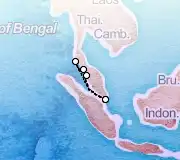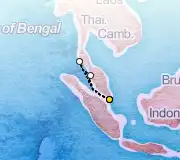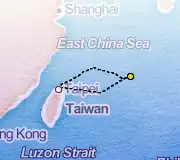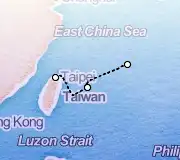An Asian cruise is a gateway to a world of diversity and intrigue. You'll sail through a continent that blends ancient traditions with modern marvels. From the high-tech cities of Japan to the tranquil waters of Halong Bay, Vietnam, there's a vast array of experiences to be had. These cruises offer a seamless way to explore Asia's rich history, stunning landscapes, and vibrant cultures. It's a journey that promises a taste of Asia's finest offerings in one unforgettable adventure.
Asian cruises feature a compelling mix of bustling hubs and serene gateways. The most frequently visited ports, such as Nagasaki, Japan, and Busan, South Korea, serve as fantastic introductions to the region. In Nagasaki, passengers can explore poignant history at the Peace Park and Atomic Bomb Museum, then wander through the charming, European-influenced Glover Garden overlooking the harbor. Busan offers a dynamic taste of South Korea, from the sprawling, sensory-rich Jagalchi Fish Market to the vibrant, art-filled alleys of Gamcheon Culture Village. These popular ports are well-equipped to handle cruise ships and provide a wide array of accessible excursions that capture the essence of their nation's history and modern energy.
For travelers seeking a deeper, more unique experience, itineraries featuring less-common ports like Kumano and Takamatsu in Japan are a true delight. Kumano is the gateway to the sacred Kumano Kodo pilgrimage routes, a network of ancient trails winding through dense forests to majestic shrines. This offers a spiritual and tranquil experience far from city crowds. Takamatsu, on the island of Shikoku, is home to the stunning Ritsurin Garden, a masterpiece of Japanese landscape design, and serves as a base for exploring the contemporary art islands of the Seto Inland Sea. These unique ports provide an intimate glimpse into the traditional culture and natural beauty of Japan, rewarding cruisers with authentic and memorable discoveries off the beaten path.
Last updated on June 20, 2025
A diverse fleet of ships navigates the waters of Asia, catering to different travel styles and preferences. Major cruise lines like Celebrity, Cunard, and Costa deploy both mega-ships and mid-sized vessels, offering a wide range of onboard experiences. Larger ships provide extensive amenities such as multiple specialty restaurants, Broadway-style shows, and family-friendly activities, making them a great choice for multi-generational travel. In contrast, smaller, more intimate ships, like those from Azamara (e.g., Azamara Quest, Azamara Pursuit), focus on destination immersion. With an average cruise length of 11 nights, these smaller vessels can often dock in more unique, less-accessible ports and typically feature longer stays and even overnights, allowing for deeper exploration.
Ships sailing in Asia are often thoughtfully tailored to the destination. Onboard programming may include lectures on Asian history and art, cooking classes featuring regional cuisine, and even basic language lessons. Luxury and premium lines often enhance the cultural connection with curated shore excursions that go beyond typical tours. Azamara ships, for example, are particularly well-suited for the region with their "Destination Immersion" philosophy, which includes exclusive "AzAmazing Evenings" that showcase local culture. The choice of ship significantly shapes the cruise experience, whether a passenger prioritizes world-class onboard entertainment or in-depth cultural discovery.
Last updated on June 20, 2025
The best time for an Asian cruise largely depends on the specific destinations on the itinerary, as the continent's weather is vast and varied. Generally, the shoulder seasons of spring (March to May) and autumn (September to November) are considered ideal. During these months, you can expect mild temperatures, lower humidity, and reduced rainfall in key regions like Japan, South Korea, and China, making for comfortable sightseeing. Spring is famous for Japan's iconic cherry blossom season, a beautiful but popular and thus more expensive time to visit. Autumn offers a spectacle of vibrant fall foliage and pleasant, crisp air. Prices and crowds are often more manageable during these shoulder months compared to the peak season.
The summer months (June to August) are characterized by heat, high humidity, and the peak of the typhoon season, which can occasionally lead to itinerary changes. However, this is also a time of vibrant local festivals. Conversely, winter (December to February) is an excellent time to cruise Southeast Asia (Vietnam, Thailand, Singapore), where the weather is dry and sunny. In Northeast Asia, winter is cold, with snow in northern Japan and South Korea, offering a completely different type of scenic beauty. For packing, light layers are key for spring and autumn. For summer, pack lightweight, breathable clothing, a rain jacket, and strong sun protection. For winter sailings that include Northeast Asia, warm coats, hats, and gloves are essential.
Last updated on June 20, 2025
Asian cruises appeal primarily to culturally curious travelers, history buffs, and adventurous foodies. This destination is perfect for those who enjoy immersive experiences and want to explore ancient traditions alongside futuristic cityscapes. With popular ports like Nagasaki, Busan, and the stunning Halong Bay, itineraries offer a rich blend of poignant history, vibrant urban life, and breathtaking natural wonders. The typical price of around $169 per person per day makes it an attainable dream for many, from seasoned empty-nesters with time for longer voyages to younger couples seeking a unique adventure. The cruise format is particularly appealing as it simplifies the logistics of a multi-country tour, eliminating the need for constant packing and unpacking and navigating complex travel arrangements.
These cruises are best suited for travelers with an active and inquisitive mindset. While many excursions are accessible, some of the most rewarding experiences, like exploring temple complexes or navigating bustling markets, require a fair amount of walking, sometimes on uneven ground. Travelers with significant mobility issues should carefully research port accessibility and tour requirements. While families can enjoy these cruises, the emphasis is more on cultural enrichment than on theme-park-style fun. Therefore, travelers seeking a purely relaxing beach vacation or a high-energy party atmosphere might find a Caribbean or Mexican Riviera cruise more to their liking. Ultimately, an Asian cruise is a phenomenal choice for anyone with a passion for discovery and a desire to experience the diverse cultures of the Far East in a comfortable and comprehensive way.
Last updated on June 20, 2025




















Overall Asian Cruises are rather expensive compared to other categories. Asian Cruises departing during the the peak season of spring are considerably more expensive than the the low season of winter. Check out the illustration below for the average cost per day by month.
Want to hear about the best deals and cruise tips every week? Sign up for our free weekly VIP Newsletter, customized exactly to your preferences!
We use cookies to personalize your experience and to help us show you the best cruises. By continuing to use this site you agree to our use of cookies. Our full privacy policy is available here